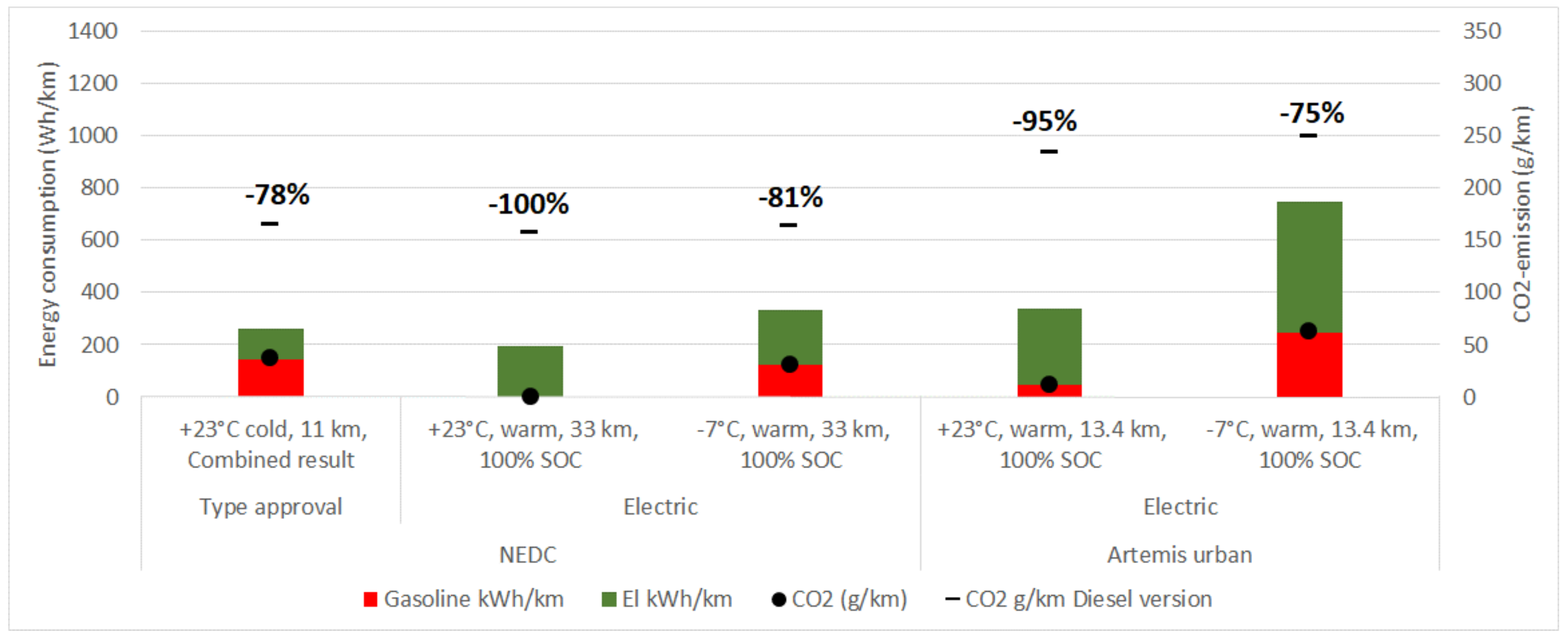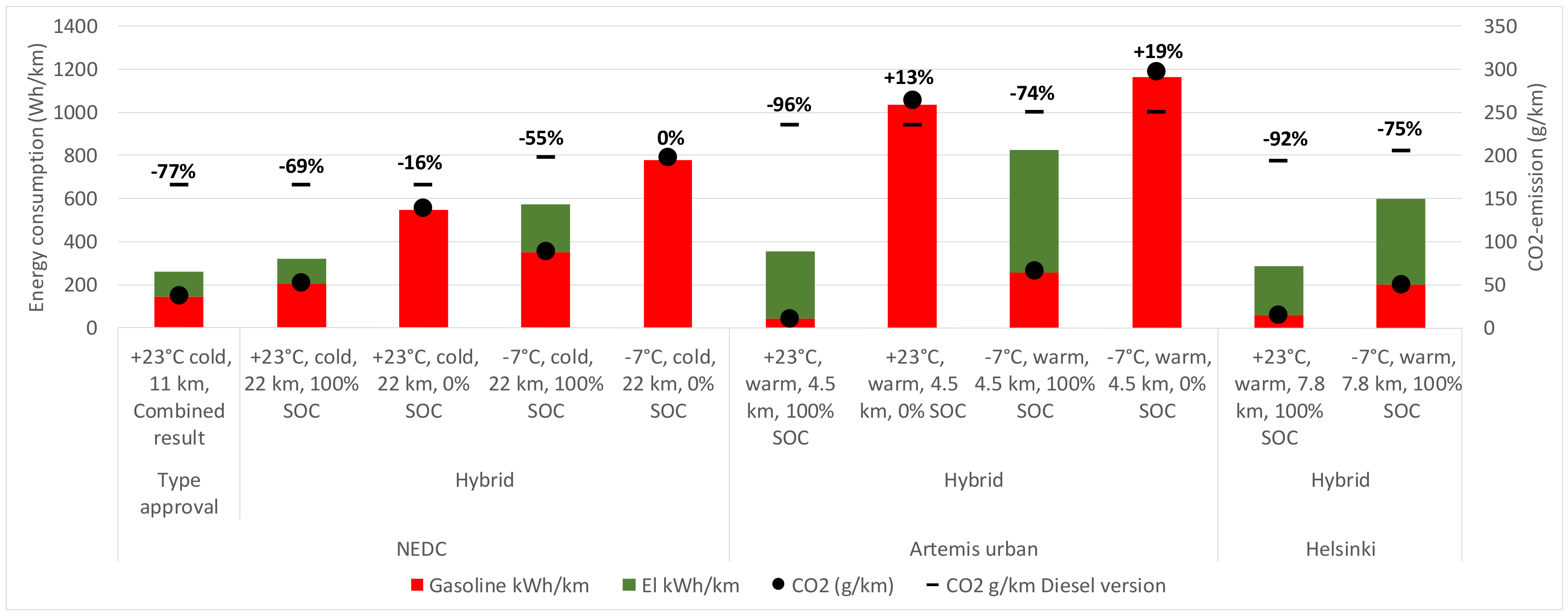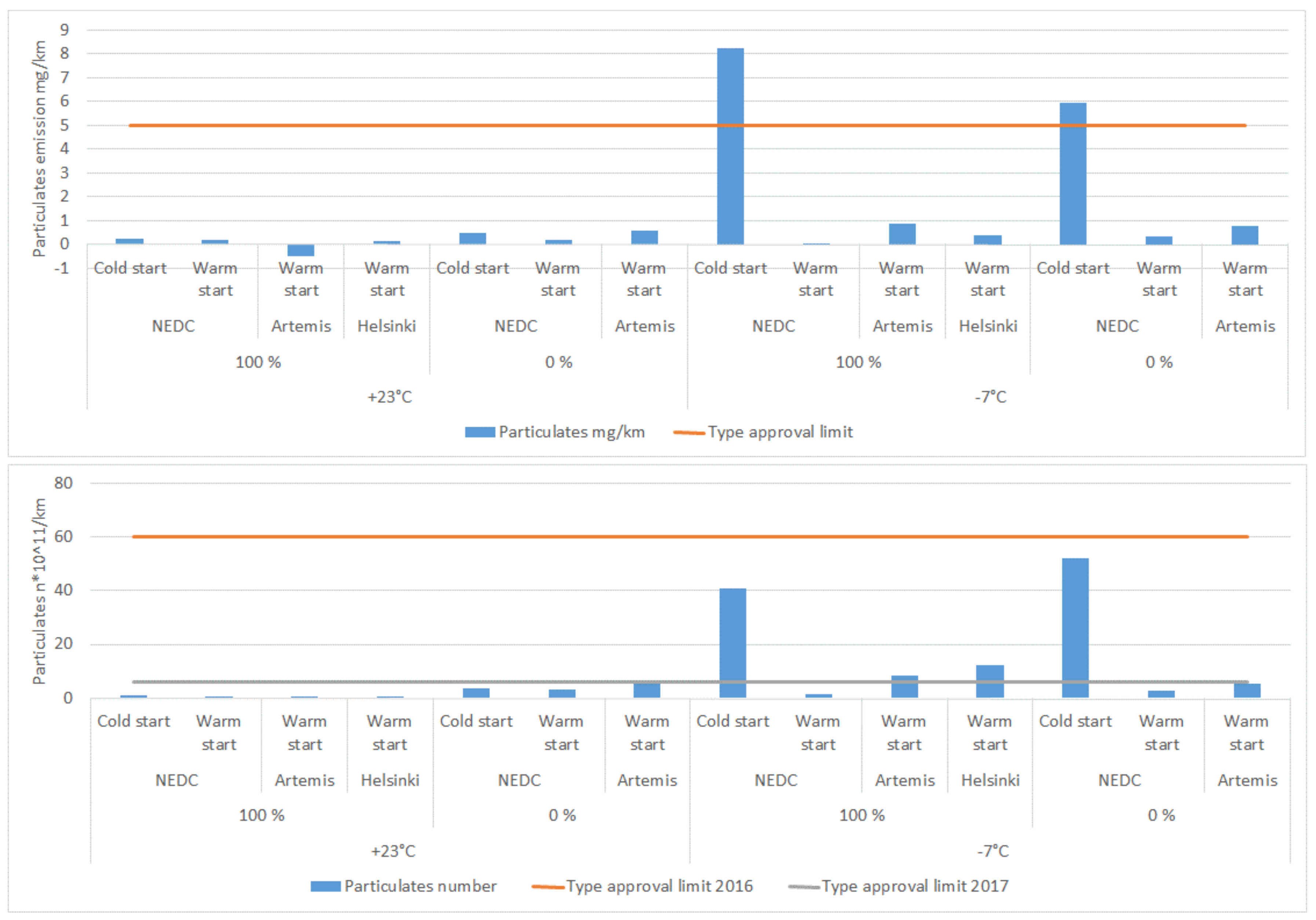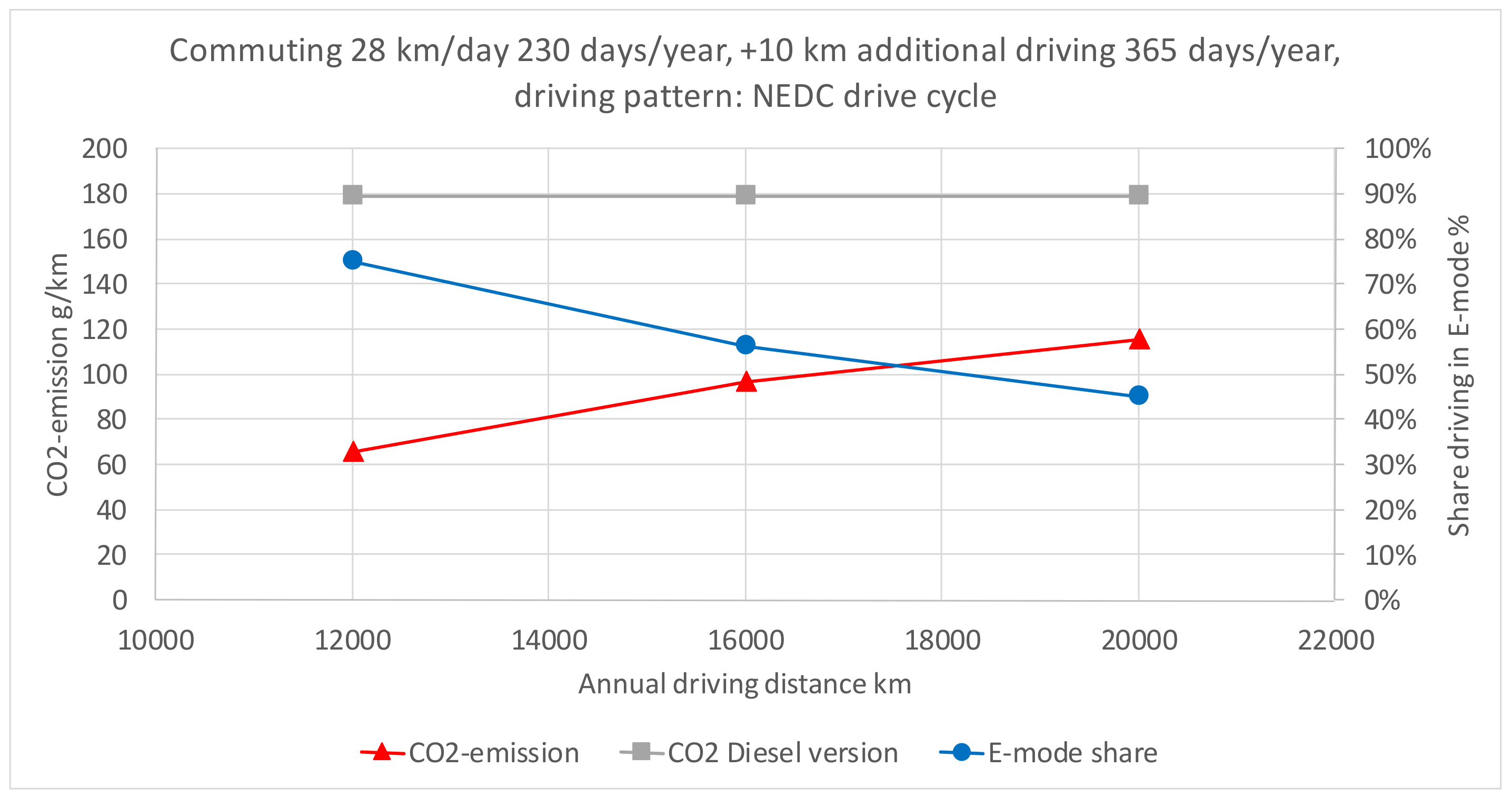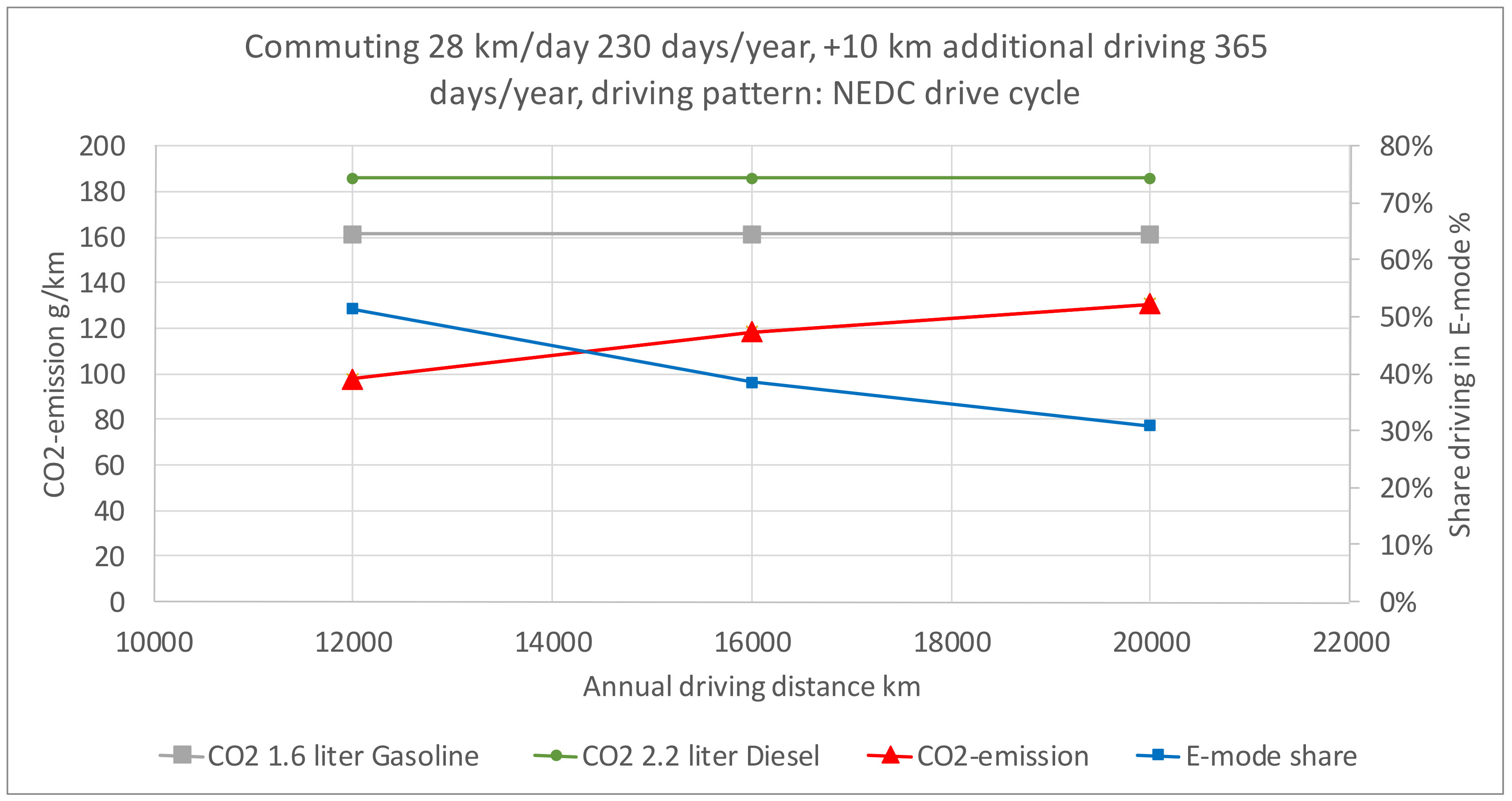1. Introduction
Electromobility is high on the political agenda in Norway. At the end of 2017, Norway had 140,000 Battery Electric Vehicles (BEVs) and 67,000 Plug-in Hybrid Vehicles (PHEVs) on the road, and market shares for each were about 20% the last year [
1]. Combined, they made up 7.5% of the total passenger vehicle fleet [
1]. The majority of these vehicles are owned by private households. Most of the national incentives are directed towards BEVs, but PHEVs are also gaining popularity.
During the winter season several, Norwegian cities experience local pollution in excess of the limits specified in the European Union (EU) directive on air quality, which has been included into Norwegian law. The overall target of the EMIROAD (emissions from road transport vehicles) project was to do research on the emission effects of different vehicle technologies in general, in Nordic cities under Nordic conditions. Nothing was known prior to 2016 about PHEVs real-world impact on the environment in the use phase under Norwegian conditions, in particular, their emissions during winter conditions and the extent these vehicles are used in their “most electric” drive mode in the summer and winter. To cover this gap of knowledge, the Norwegian EMIROAD (emissions from road transport vehicles) research program initiated experimental testing of PHEV emissions and energy use under simulated Norwegian traffic and climatic conditions [
2].
This article presents the results of the experimental testing of the exhaust emission and energy consumption of two gasoline plug-in hybrid vehicles in an emission testing laboratory. The aim of the testing was to uncover the impact of these PHEVs on local pollutants, CO
2-emissions, and energy use in Norwegian driving conditions in the summer and winter. The usage pattern of PHEVs was established and compared with the usage pattern of BEVs and Internal Combustion Engine Vehicles (ICEVs) using data from a survey of owners of these vehicle types [
3]. The usage patterns from the survey are combined with the experimental results, to produce the first real world estimate of the environmental impact from the use phase under Norwegian driving conditions of PHEVs, compared to similar ICEVs.
This articles main contribution to the research literature is the increased understanding of real driving behavior of consumers owning PHEVs, and estimates of real world emissions under demanding driving conditions, in particular in cold Nordic climates.
The article starts off in
Section 2 with a presentation of the materials, methods and theoretical framework for the evaluation of the environmental characteristics of PHEVs. The results are presented in
Section 3, followed by a discussion of the overall results in
Section 4, and the conclusion in
Section 5.
2. Materials and Methods
2.1. Theoretical Framework
A Hybrid Electric Vehicle (HEV) uses a battery and an electric motor/generator to capture brake energy to generate electricity that recharges the battery. This captured brake energy can subsequently be extracted and used in the electric motor to assist in the propulsion of the vehicle and thus save fuel. The batteries in these vehicles cannot be externally recharged, and the capacity is much smaller than for BEVs or PHEVs.
The PHEV can, on the other hand, utilize grid electricity charged into the vehicle’s batteries for propulsion over typical distances of 20–80 km, depending on the battery capacity and the vehicle configuration. Charge depletion PHEVs first drain the battery in electric drive-mode (E-mode) before starting the Internal Combustion Engine (ICE) on longer driving distances. Blended mode PHEVs allow the ICE to also run when the power in the electrical system is insufficient. The ICE supports propulsion directly on the drive shaft or indirectly through electricity produced by a generator connected the ICE.
This duality of power sources and engine/motors in different configurations introduces flexibility for the user and complexity for researchers aiming to understand the environmental impacts of PHEVs. The user can select different drive modes where the ICE may operate to a larger or lesser extent, thus further complicating the picture.
Figure 1 shows an example of a PHEV lay-out with an overview of typical user selectable drive modes.
The real traffic propulsion system usage patterns can be much more diversified for these PHEVs, with their multitude of user selectable drive modes, than for ICEVs, that only use an Internal Combustion Engine (gasoline or diesel) for propulsion. It is, therefore, no longer adequate to measure the energy consumption, the emission of CO2, and local pollutants in a laboratory simulating real traffic to establish an estimate of these vehicles’ environmental impacts. One also needs to take into consideration the actual usage pattern of the vehicles and the users’ selection of drive modes.
Two main drive modes exist for PHEVs. Charge Depletion (CD) in which the strategy is to use electric propulsion as much as possible until the Battery State of Charge (SOC) is too low to continue, then the vehicle enters the Charge Sustain drive mode in which the Battery charge is sustained and the vehicle essentially operates as a traditional hybrid vehicle. The potential to reduce the environmental impact of PHEVs rests on the share of driving that can be, and is, accomplished in the CD mode. This share of driving will differ substantially between summer and winter conditions due to the large differences in energy consumption caused by the heating system, the use of winter tires, and the increased driving resistance in cold climates. The range of the vehicle in the all-electric (or the most electric drive mode) is called the All Electric Range (AER), the share of driving in AER is called the utility factor (UF). In the New European Driving Cycle (NEDS) official range test used up to 2018 in Europe, the UF is essentially: AER/(AER + 25), with the factor 25 set more or less arbitrary [
4].
The actual usage profile will influence emissions. Owners can charge frequently or infrequently, or drive long distances so that even frequent charging will lead to a low share of electrically-powered kilometers. Others maximize the share of driving in the electric drive mode by charging whenever possible. It is also possible to own and operate a PHEV without ever charging it from the grid.
In drive modes where the ICE is activated, the emissions may be higher than for comparably sized HEVs due to the extra weight of the larger batteries and the battery charger and other extra components, differences in the layout of the drive system, and the operation strategy of the ICE. Additional emissions could occur if the ICE starts and stops frequently and operates in short time intervals only. Some early PHEVs, such as the first generation Prius, are designed to always start the ICE when starting the vehicle under cold ambient conditions. The ICE then produces heat that can be used to defrost the windshield. As the vehicle can utilize some of the surplus heat from the ICE for heating the vehicle, the efficiency of this operation will be higher than when the ICE only supplies propulsion power.
The research literature on emissions from PHEVs mainly covers emissions and fuel consumption under warm weather conditions such as in California. Little work has been done on the operation of PHEVs in cold weather, more work has focused on BEVs due to the range decrease they experience in cold weather [
5]. Plötz et al. [
6] reviewed the UF for data from Germany and the United States of America (USA), including data from the California Air-Resources Board (CARB) [
7] and the consumer website Spritmonitor.de. Their main conclusion is that an all-electric range of 40 km (according to the US Environmental Protection Agency range test) gives a UF of 0.5, 60 km a UF of about 0.75, and 25 km a UF of about 0.3. The CARB found that off-cycle high-power accelerations in blended mode 1st generation PHEVs can cause excessive exhaust emissions due to high-power cold starts of the ICE [
8]. They also found that the overall average emission of these PHEVs could be within the emission limit values, as only a fraction of engine starts were of this type. That fraction will be smaller the longer is the range in E-mode. Smart et al. [
9] found that the average UF of the General Motors (GM) Volt (Opel Ampera is the European version of the vehicle) was 72–74%, and that owners charged on average 1.4 times per day, with an average AER of 56–62 km depending on year model. Bradley and Quinn [
10] found that the assumption on charging frequency significantly influences the UF. Hardman et al. [
11] found that up to 80% of consumers in general charge their electric vehicles (BEVs + PHEVs) at home, with work charging being the second most important location covering 15–20% of recharge events. Nicholas et al. found that for the Chevrolet Volt, 86% of kWh’s are charged at home [
12].
Fleetcarma [
13] found that in their vehicle fleets, the AER range of the Chevrolet Volt decreased 48% when the ambient temperature was reduced from 20 °C to 0 °C, and that the engine started when the temperature dropped below −4 °C. Tietge et al. [
14,
15] found that the real CO
2-emissions of PHEVs are typically more than 2 times higher than their type approval value. Volvo has stated that the V60 PHEV in Norway is operated 46.3% of the time in E-mode based on data collected from 341 vehicles driven close to 8 million km [
16].
2.2. Targets and Strategy for the Measurement Program and User Survey
The purpose of the measurement program of PHEVs and the survey of PHEV owners was to obtain a basic understanding of how PHEVs operate in Norway under various real traffic and climatic conditions, in line with the overall targets of the EMIROAD research program. The tests were carried out at VTT’s emission laboratory in Finland in close co-operation with their test engineers. The data cannot be used to estimate the average emissions or energy consumptions of the total fleet of PHEVs on the road, as only two vehicles were tested. The tests were deliberately designed to be exploratory, i.e., to also find the unexpected rather than focusing on the average.
The questions that prompted the need to measure PHEVs and survey owners were:
What is the range and energy consumption when PHEVs are driven in the electric drive mode?
What is the share of driving that is done in E-mode?
What is the influence of climate and driving conditions on energy use, range, and emissions?
An exploratory measurement program [
2] using the combination of laboratory measurements and user survey results was designed to be able to shed light on these questions, and the following assumptions were made about PHEVs’ characteristics and environmental impacts:
PHEVs have a pure battery electric drive mode in warm as well as cold climates.
Battery range is sufficient for everyday traffic, i.e., longer than an average round trip to work.
The energy consumption in non-electric modes can be higher than for comparable HEVs/ICEVs.
Frequent starts and stops of the drive system in hybrid mode can lead to high emissions.
The annual average energy use and CO2-emission of PHEVs will be much lower than for ICEVs.
A pure E-mode is not necessarily better from a CO2-reduction perspective than a blended E-mode.
Pure electric propulsion does not produce exhaust emissions. Therefore, the CO
2- and local emissions for pure electric propulsion is regarded as zero in the measurement program. Emissions related to production and distribution of vehicles and fuels are thus not taken into account in the analysis in this article. For a global estimation of total greenhouse gas emissions of a PHEV, WTW (well-to-wheel) emissions, including emissions from generation/extraction, conditioning, and transportation of the fuel/electricity, as well as the production of vehicles, should be accounted for. Note that this is the case both for the electricity and the liquid fuel used by the vehicle. Norway does not produce vehicles, and 96% of the electricity is produced from hydro-electric power and 2% from wind power. The European Union Emission Trading System (EU ETS) for greenhouse gases will also nullify the effect of these additional emissions [
17] under the condition that the EU ETS is effective in capping CO
2-emissions [
18]. The emission of individual countries can, however, be affected, which is why countries and the EU now set non-ETS sector climate policy targets [
19]. It is also worth noting that it is individual countries that take on the responsibilities to reduce climate gas emissions in international agreements. The borders of the analysis system will then be the emission producing processes that goes on within national borders. The zero emission assumption for pure electric propulsion used in this article is thus justifiable, when the target is to analyze national Norwegian emission impacts of replacing ICEVs with PHEVs.
2.3. Measurement Program
The test program [
2] consisted of two vehicles, tested in three different drive cycles, at two ambient temperatures, and 2–4 user selectable drive modes. The characteristics of the two vehicles tested are presented in
Table 1. The results have been compared to emission tests of gasoline/diesel variants of the same vehicles, see
Table 2. These tests were also carried out within the EMIROAD research program.
The laboratory tests included measurements of energy use, the emission of CO
2, and “local” emissions, i.e., HC, CO, NO
X, and particulates’ mass and number count. The test cell set up is illustrated in
Figure 2.
Three different drive cycles were applied: the NEDC, Artemis Urban, and Helsinki city cycles.
Table 3 presents some essential characteristics of the test cycles.
The test matrices are summarized in
Table 4 and
Table 5. The tests included warm and cold starts, driving in different hybrid system drive modes, and at ambient temperatures of +23 °C and −7 °C. It is thus possible to analyze:
Implication of drive cycles, i.e., different usage and driving styles
Implication of the vehicles selectable drive modes
Implication of cold weather versus warm weather
Implication of fully charged versus depleted battery
The detailed schedules for the tests are presented in
Appendix A. Vehicle A spent 9 days in the laboratory, vehicle B 8 days. All cold starts where done after a full overnight soak in the laboratory at the set temperatures. Several warm start tests were done during one day of testing as seen in the schedules.
The purpose of the EMIROAD project is to measure real on-road emissions from vehicles. All vehicles in the EMIROAD program are tested as they are delivered, i.e., in road-worthy condition with various standard/extra equipment installed, with the tires that were on the vehicle when they came to the laboratory. The tire pressure is set to the manufacturers’ specified value. Climate controls are set at +21 °C, with the fan in the second lowest speed. The vehicles are in use when they are selected for the testing.
2.4. User Survey Design
In real traffic, PHEVs will be used part-time in different user selectable drive modes and with different use patterns. A user survey [
3] among 2065 private Norwegian PHEV owners, 3111 BEV owners, and 2080 ICEV owners was conducted in March 2016. Among the questions were the users’ own estimates of the real E-mode range in summer and winter, the total annual km driven, the estimated share of driving done in E-mode, and the charging behavior [
3]. The survey results were used to estimate a representative usage and charging pattern that is combined with the measurements to provide estimates of how these vehicles contribute to reduced CO
2-emission, less energy use, and local pollution over a year of use, compared with an ICEV of similar type.
4. Discussion
PHEVs produce very different amounts of CO2-emission and local pollutants depending on configuration, manufacturer strategy, user preferences and drive mode selection, driving pattern, and driving conditions. The energy consumption and mix between electricity and gasoline varies accordingly.
The most important characteristics of PHEVs is the share of driving that can be accomplished in E-mode. This drive mode is assumed to be the primary reason for consumers to buy a PHEV rather than a HEV. Eighty-nine percent of the PHEV owners in the user survey saw electric driving locally as a primary reason to buy a PHEV [
3]. The larger the share of driving in E-mode, the lower the fuel consumption, CO
2-emission, and local pollution will be. The estimates of these vehicles’ average CO
2-emission over a year demonstrates, however, that it is rather the range in E-mode rather than the ability to drive purely in the E-mode that is critical to achieve low average yearly CO
2-emissions.
When these vehicles are used for about 15,000 km/year [
3], the real-world CO
2-emission would be 50% less than the emission from a similar ICEV for the compact vehicle and 30% for the mid-sized vehicle, i.e., proportional to E-mode range. The assumption is that E-mode driving is used for commuting and local driving and the “0% SOC hybrid auto mode” is used for the remaining driving.
These CO
2 reduction numbers are slightly lower than the estimates that Plötz et al. [
6] produced. They found that the share of electric km driven is about 60% for a 50 km electric range PHEV and about 35% for a 30 km electric range PHEV. The cold Norwegian winters, taken into account in the calculations for Norway, could be a reason for these differences.
Drivers driving longer annual distances, i.e., more than 15,000 km/year, will see a smaller reduction (
Figure 7) and those that drive less will achieve a larger reduction. Aggressive driving can lead to less reduction potential based on the results measured in the Artemis Urban drive cycle (Figenbaum and Weber 2016).
In Vehicle B the electric mode is pure electric, whereas in Vehicle A it can be characterized as being “mostly” electric supported by the ICE at medium to high loads and under unfavorable climatic conditions. Driving in the hybrid mode of Vehicle B was done purely electrically in many drive cycles and driving conditions.
This observed and measured vehicle behavior does not necessary lead to the general conclusion that Vehicle B will produce less CO2-emissions per year than Vehicle A. It will depend on how the vehicles are used. Vehicle A has a longer range in E-mode and a larger battery, so overall it will be able to do more driving in electric mode than Vehicle B can do, but potentially the driving in E-mode will be more spread out over a trip. Overall, Vehicle A is expected to produce less CO2 over a year of 16,000 km of average driving than Vehicle B, due to the longer E-mode range and the larger battery.
For both vehicles, low temperatures and aggressive driving reduced the range in E-mode, and increased the energy consumption in all drive modes and drive cycles tested. The same situation applies also for ICEVs.
The emissions of NO
X and particulates can be high in more demanding drive cycles such as the Artemis Urban Cycle, in low temperatures, and when driving with an empty battery. One specific case that can lead to excess local emissions was not tested. The CARB has found [
8] that starting to drive a blended mode (vehicle A) PHEV in E-mode can lead to high power cold starts that cause high emissions, but all E-mode testing of vehicle A was done with a semi-warm vehicle. Due to this issue, the overall effects on local pollution of operation of vehicle A over a year remains uncertain. Vehicle B operates in pure electric CD mode and is unlikely on average to produce emissions above the emission limit value.
The cold weather tests presented in this report were done at −7 °C, so issues with potential E-mode cut-off at low ambient temperatures, as some manufacturers do to protect the battery, was not encountered. One manufacturer for instance shuts off the system at less than −10 °C. Vehicles with that type of strategy will produce higher average emissions under Norwegian conditions than estimated in this paper.
Driving in the battery charge and battery hold modes, respectively, recharging the battery, and preserving the battery SOC, resulted in very high emissions of CO2 and high energy consumption in Vehicle A. These modes will allow for a later part of the journey to be conducted with electric power, for instance in a zero-emission city zone, or in sports mode, and thus be desirable functions for some users.
Coming back to the assumptions in
Section 2.1, it is evident that:
Some PHEVs have a pure battery electric drive mode in warm as well as cold climates, others do not.
Battery range is not sufficient to cover average everyday traffic in the winter in Norway.
The energy consumption in non-electric modes can be higher than for comparable ICEVs/HEVs.
The start and stop of the drive system in hybrid mode can lead to high emissions, but the average emissions will likely stay below the type approval value.
Under Norwegian usage patterns and climatic conditions, the total energy consumption and CO2-emissions can be about 30–50% lower from PHEVs than those from comparable ICEVs.
The partially blended electric/ICE operation of Vehicle A in E-mode is not an issue when it comes to reducing CO2-emission and energy consumption over a year. E-mode range is the most important parameter in reducing emissions.
Some PHEVs do not allow electrical operation when temperature falls below −10 °C to protect the batteries. Such behavior could not be detected, since the vehicles were tested at −7 °C. The survey only covered privately owned PHEVs. Private users are likely to utilize the PHEVs electric range capability and recharge overnight to reduce their cost of driving as it is cheaper to operate the vehicle on electricity than gasoline. People using a leased company car with fuel payed for by the company may not have the same incentive [
3].
5. Conclusions
The variation in CO2-emissions was huge for these vehicles when driving in different user selectable drive modes, different drive cycles, temperatures, and SOC levels. The variation is much larger than for an ICEV, in particular for CO2. The conclusion is, therefore, that PHEVs are a vehicle type that needs to match well with the usage pattern to produce low CO2- and local pollutant emissions. The vehicles’ range in E-mode is indicative of real-world performance, as longer ranges lead to a higher share of electric mode driving and less CO2-emissions, as long as the vehicle is plugged in and charged frequently. The two vehicles produced CO2-emission reductions proportional to the range in E-mode when considering an average usage pattern. A 50 km type approved NEDC range lead to a 50% reduction estimate in real traffic conditions, and a 31 km E-mode range to about a 30% reduction, assuming daily recharging at home.
Whether the vehicle has a pure electric drive mode or not seems to be less important for the overall result than the range in E-mode. The average yearly estimated CO2-emission was about 2.5 times higher than the value stated in the type approval official CO2-emission test. Larger CO2-reductions can be achieved with optimum driving patterns, i.e., predominantly local, short-distance driving, and relatively few long distance trips. Less CO2-reduction (measured in percentage) will be achieved if drivers have a large share of long distance trips. The benefits could then become marginal compared with HEVs as PHEVs are heavier and thus have high energy consumption when used as a HEV than do regular HEVs. This issue becomes even more important when factoring in emission differences in vehicle production.
Policies that can provide users with incentives to charge their vehicle as often as possible should be considered. Enterprises that offer employees company cars should make sure that the vehicles are recharged.
Some specific user selectable drive modes and demanding driving patterns, especially in cold climate, could lead to excessive local pollutant emissions (over type approval limits). On average, vehicle B is expected to produce local emissions below the emission limit values when they are driven partly on electricity. For vehicle A, an important condition that can cause excessive emissions in E-mode, high power cold starts of the engine, was not tested and the results are inconclusive.
Charging at work or other places during the day can significantly improve the environmental benefits of the current generation of PHEVs by increasing the E-mode share of the driving over the year.




